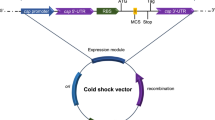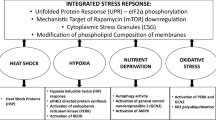Abstract
In recent years there have been a number of reports that suggest the sub-physiological (<37 °C) temperature in vitro culturing of mammalian cells can result in enhanced heterologous protein production. Despite these reports, the mechanisms by which mammalian cells respond to such conditions are largely unknown. We therefore set out to use a model in vitro culture HeLa cell system to begin investigating the cold-shock response in mammalian cell systems. Sub-physiological temperature cultivation resulted in reduced growth and proliferation and a lower total cell protein content. Proteomic analysis confirmed that HeLa cells actively respond to sub-physiological temperature by up-regulating a number of proteins and immunoblot analysis confirmed that specific proteins are indeed up-regulated in a time and temperature dependent manner. Additional work is likely to improve our understanding of the cold-shock response in mammalian cells and identify candidate target proteins for cell engineering to further enhance heterologous protein production at sub-physiological temperatures.


Similar content being viewed by others
References
Al-Fageeh MB, Marchant RJ, Carden MJ, Smales CM (2006) The cold-shock response in cultured mammalian cells: harnessing the response for the improvement of recombinant protein production. Biotechnol Bioeng 93:829–835
Al-Fageeh MB, Smales CM (2006) Control and regulation of the cellular responses to cold shock: the responses in yeast and mammalian systems. Biochem J 397:247–259
Baik JY, Lee MS, An SR, Yoon SK, Joo EJ, Kim YH, Park HW, Lee GM (2006) Initial transcriptome and proteome analyses of low culture temperature-induced expression in CHO cells producing erythropoietin. Biotechnol Bioeng 93:361–371
Beer C, Buhr P, Hahn H, Laubner D, Wirth M (2003) Gene expression analysis of murine cells producing amphotropic mouse leukaemia virus at a cultivation temperature of 32 and 37 degrees C. J Gen Virol 84:1677–1686
Ducommun P, Ruffieux PA, Kadouri A, von Stockar U, Marison I W (2002) Monitoring of temperature effects on animal cell metabolism in a packed bed process. Biotechnol Bioeng 77:838–842
Fogolin MB, Wagner R, Etcheverrigaray M, Kratje R (2004) Impact of temperature reduction and expression of yeast pyruvate carboxylase on hGM-CSF-producing CHO cells. J Biotechnol 109:179–191
Fountoulakis M, Tsangaris G, Oh JE, Maris A, Lubec G (2004) Protein profile of the HeLa cell line. J Chromatogr A 1038:247–265
Fox SR, Patel UA, Yap MG, Wang DIC (2004) Maximizing interferon-gamma production by Chinese hamster ovary cells through temperature shift optimization: experimental and modeling. Biotechnol Bioeng 85:177–184
Fox SR, Tan HK, Tan MC, Wong S, Yap MGS, Wang DIC (2005a) A detailed understanding of the enhanced hypothermic productivity of interferon-gamma by Chinese-hamster ovary cells. Biotechnol Appl Biochem 41:255–264
Fox SR, Yap MX, Yap MG, Wang DIC (2005b) Active hypothermic growth: a novel means for increasing total interferon-gamma production by Chinese-hamster ovary cells. Biotechnol Appl Biochem 41:265–272
Inouye S, Izu H, Takaki E, Suzuki H, Shirai M, Yokota Y, Ichikawa H, Fujimoto M, Nakai A (2004) Impaired IgG production in mice deficient for heat shock transcription factor 1. J Biol Chem 279:38701–38709
Kaufmann H, Mazur X, Fussenegger M, Bailey JE (1999) Influence of low temperature on productivity, proteome and protein phosphorylation of CHO cells. Biotechnol Bioeng 63:573–582
Moore A, Mercer J, Dutina G, Donahue CJ, Bauer KD, Mather JP, Etcheverry T, Ryll T (1997) Effects of temperature shift on cell cycle, apoptosis and nucleotide pools in CHO cell batch cultues. Cytotechnology 23:47–54
Ohsaka Y, Ohgiya S, Hoshino T, Ishizaki K (2002) Phosphorylation of c-Jun N-terminal kinase in human hepatoblastoma cells is transiently increased by cold exposure and further enhanced by subsequent warm incubation of the cells. Cell Physiol Biochem 12:111–118
Ramagli LS (1999) Quantifying protein in 2-D PAGE solubilization buffers. In: Link AJ (ed) Methods in molecular biology. 2-D proteome analysis protocols. Humana Press Inc, Totowa, NJ pp. 99–103
Schatz SM, Kerschbaumer RJ, Gerstenbauer G, Kral M, Dorner F, Scheiflinger F (2003) Higher expression of Fab antibody fragments in a CHO cell line at reduced temperature. Biotechnol Bioeng 84:433–438
Smales CM, Birch JR, Racher AJ, Marshall CT, James DC (2003) Evaluation of individual protein errors in silver-stained two-dimensional gels. Biochem Biophys Res Commun 306:1050–1055
Smales CM, Dinnis DM, Stansfield SH, Alete DE, Sage EA, Birch JR, Racher AJ, Marshall CT, James DC (2004) Comparative proteomic analysis of GS-NS0 murine myeloma cell lines with varying recombinant monoclonal antibody production rate. Biotechnol Bioeng 88:474–488
Underhill MF, Birch JR, Smales CM, Naylor LH (2005) eIF2alpha phosphorylation, stress perception, and the shutdown of global protein synthesis in cultured CHO cells. Biotechnol Bioeng 89:805–814
Yoon SK, Kim SH, Lee GM (2003a) Effect of low culture temperature on specific productivity and transcription level of anti-4–1BB antibody in recombinant Chinese hamster ovary cells. Biotechnol Prog 19:1383–1386
Yoon SK, Song JY, Lee GM (2003b) Effect of low culture temperature on specific productivity, transcription level, and heterogeneity of erythropoietin in Chinese hamster ovary cells. Biotechnol Bioeng 82:289–298
Acknowledgements
This work was partially supported by Grant BB/C006569/1 from the Biotechnology and Biological Sciences Research Council, UK.
Author information
Authors and Affiliations
Corresponding author
Additional information
A manuscript submitted from the Global mRNA and Protein Expression Analysis, Research Applications in Cancer and other Diseases and in Biopharmaceutical Production conference, Dublin City University, Dublin 9, Ireland, September 7–8th 2006
Rights and permissions
About this article
Cite this article
Underhill, M.F., Smales, C.M. The cold-shock response in mammalian cells: investigating the HeLa cell cold-shock proteome. Cytotechnology 53, 47–53 (2007). https://doi.org/10.1007/s10616-007-9048-5
Received:
Accepted:
Published:
Issue Date:
DOI: https://doi.org/10.1007/s10616-007-9048-5




